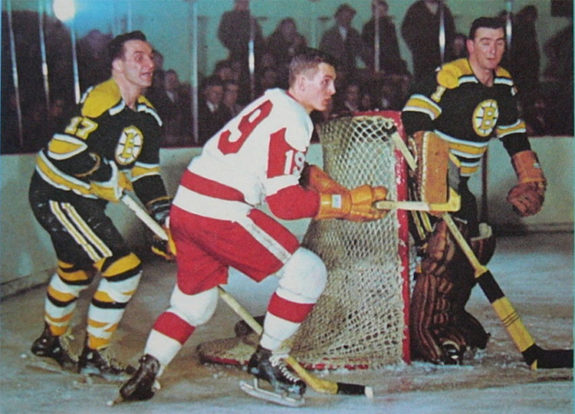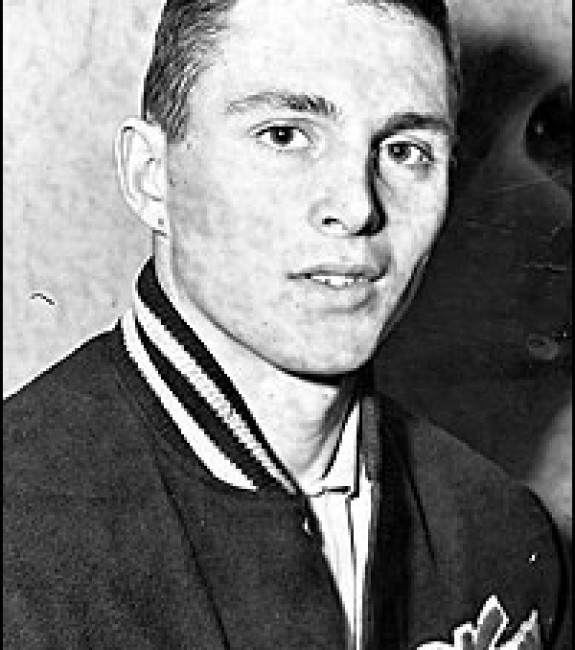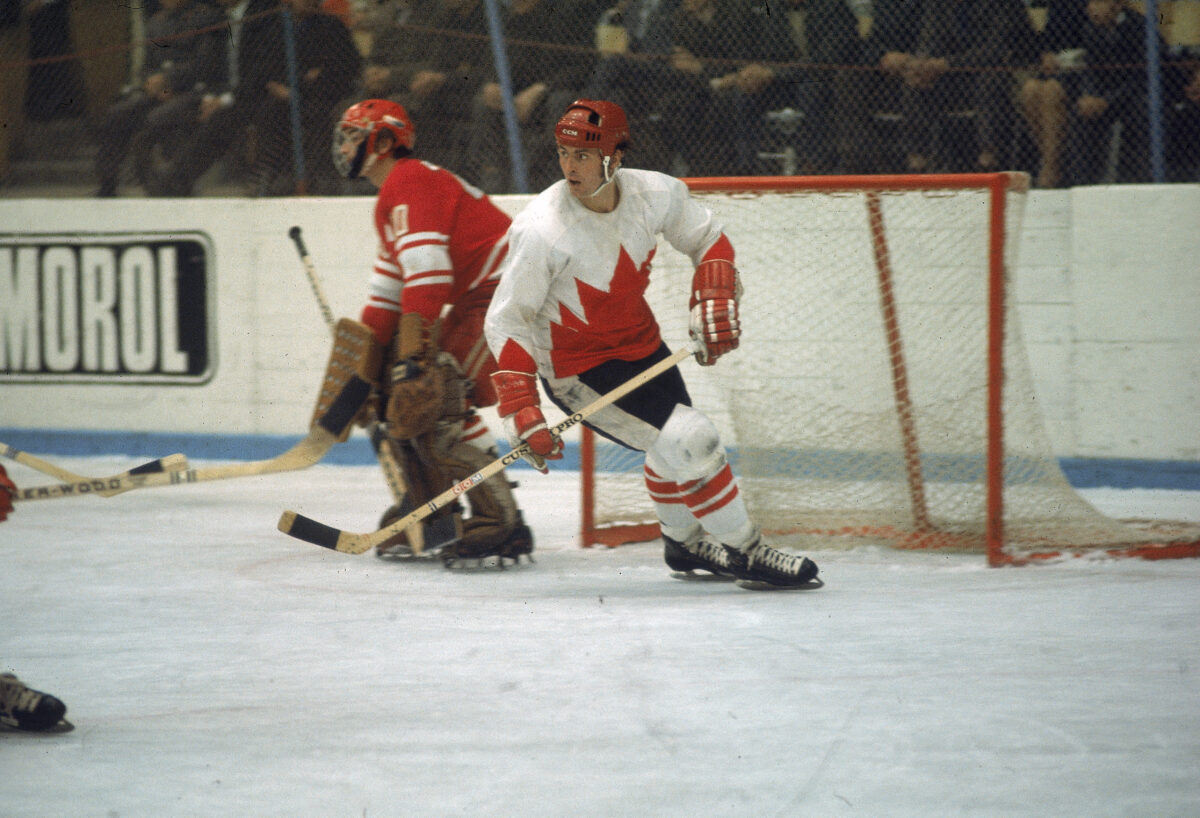Paul Henderson is best remembered for being a Canadian hero during the Summit Series of 1972, but his career and life have more to offer than just eight games. He played over 1,000 professional games between the NHL and World Hockey Association (WHA). He was a multiple-time NHL All-Star and a Memorial Cup winner. After he hung up his skates, he became a minister, a successful motivational speaker, and an author.
From a “Miracle” Birth to the Memorial Cup
Henderson’s birth was called a miracle by his mother, Evelyn. On Jan. 28, 1943, she went into labor while on her parents’ farm, in a snowstorm, near Kincardine, Ontario. She gave birth to Paul riding on a horse-drawn sleigh crossing Lake Huron in an attempt to get to the local hospital. Paul did not meet his father Garnet until he was almost three years old because he was overseas fighting for Canada in World War II.
Sign up for our NHL History Substack newsletter
The future NHL All-Star got his first taste of hockey while playing in the basement of the local Chinese Restaurant owned by Charlie Chin. It was Chin who bought Henderson his first set of hockey equipment, and he began to play for youth teams coached by his father. According to his 2012 memoir The Goal of my Life, his father told his teammates to “just give the puck to Paul and get out of his way.” Henderson wrote that this initially embarrassed him as he felt singled out. However, later in life, he realized that his father was showing pride in his talent.
He married his wife Eleanor in 1962 and was ready to become a history and physical education teacher. With some convincing from his dad, Henderson decided to give hockey a shot for two more seasons to see what happened. That turned out to be a very wise decision.

In 1962, Henderson led the Hamilton Red Wings to the Ontario and Eastern Canadian championships. They beat the Edmonton Oil Kings four games to one in the best-of-seven series to win the Memorial Cup. He had seven goals and 14 points in 14 Memorial Cup playoff games. He led the Ontario Hockey Association with 49 goals in 48 games the following season.
Henderson got his first taste of the NHL by dressing in two games for Detroit at the end of the season. However, he only played one shift in each game. In his debut against the Toronto Maple Leafs, he elbowed Dick Duff in the head and caused a fight. He was kept on the bench as several Maple Leafs threatened retaliation. In his second game against Toronto the following night, he drew a slashing penalty in his lone shift. He racked up nine penalty minutes in roughly 20 seconds of ice time in his two games.
From Detroit to Toronto

Henderson did not make the Red Wings roster out of training camp for the 1963-64 season. He began the year with the Pittsburgh Hornets in the American Hockey League (AHL). After scoring 10 goals and 24 points in 38 games, he became a permanent member of the NHL roster in early January. He had three goals and six points in 32 regular-season games. The young winger came up big in his first taste of postseason action with two goals and five points as the Red Wings made it to the Stanley Cup Final, where they lost in seven games to the Maple Leafs.
The Red Wings used Henderson in primarily a defensive role in 1964-65, but he got a more significant role within the offense the following season. He scored a career-high 22 goals and helped Detroit to another Stanley Cup Final appearance. He scored the game-winning goal in Game 2 to give the Red Wings a 2-0 lead in the championship series, but they lost the next four games to the Montreal Canadiens.
The 1966-67 season started with a contract dispute with Red Wings management, but he eventually got the double in salary he was looking for at $14,000. He was limited to 46 games thanks to a case of tracheitis that led him to spend time in the dry air of Arizona to recover. A torn chest muscle caused him to miss about a third of the season, but he still scored 21 goals and 40 points. With the team in last place the following season, on March 3, 1968, Henderson was traded to the Toronto Maple Leafs as part of a six-player deal, along with Norm Ullman and Floyd Smith, in exchange for Frank Mahovlich, Garry Unger, and Pete Stemkowski.
Related – Frank Mahovlich: Highs & Lows of a Hall of Fame Career
In his first full season in Toronto, 1968-69, Henderson set new career highs with 27 goals, 32 assists, and 59 points. A groin injury hampered him for much of the following season, but he still put up 20 goals and 40 points. Back to full health for the 1970-71 season, he scored 30 goals for the first time in his career and had his first 60-point season. In 73 games the following season, he scored a career-high 38 goals. These back-to-back 30-goal efforts and his hard-nosed style of play earned him a chance to play in the games that made him a national hero.
Summit Series Makes Henderson a Canadian Legend
For years, the Soviet Union dominated the international stage because they found a loophole where their best professional players could keep their amateur statuses. Meanwhile, other powerhouses like Canada sent junior and college players to tournaments like the Olympics and World Championships. Eventually, officials from Canada and the Soviet Union agreed to meet in an eight-game “Summit Series” that would feature the top professional players from each country.
Henderson was part of a Canadian roster full of all-time greats like Phil and Tony Esposito, Bobby Clarke, Rod Gilbert, Stan Mikita, and Ken Dryden. Many around the world felt that Canada would win all eight games of the series, but that was quickly learned not to be the case.
The first game of the series was played at The Forum in Montreal, and Henderson helped Team Canada get out to an early 2-0 lead. However, the Soviets dominated from there and stunned a nation with a 7-3 win. After a 4-1 Game 2 win in Toronto, the series went west to Vancouver. Henderson scored another goal in Game 3 as the teams skated to a 4-4 tie. Canada heard loud boos from the faithful in Vancouver after a 5-3 loss in Game 4.
The series shifted to Moscow for the final four games with the Soviets in command. Henderson scored a goal to help the Canadians build a 4-1 lead before being knocked unconscious after being tripped into the boards. He returned to finish the game, but Team Canada choked away their lead and lost 5-4.

Game 6 saw Henderson score the game-winning goal in a 3-2 Canada victory. However, this game is best remembered for Clarke’s two-handed slash that broke Soviet star Valeri Kharlamov’s ankle. During a press conference about the 30th anniversary of the Summit Series, Henderson called Clarke’s slash “the low point of the series.”
Team Canada evened the series at 3-3-1 after Henderson nabbed another game-winning goal in a 4-3 defeat of the Soviets. This set up a winner-take-all eighth and final game. An estimated 50 million people watched the game in the Soviet Union, while offices and schools in Canada closed while the game was on.
Before the teams even took the ice, there was controversy. The Canadians complained about unfair officiating since the series shifted to Moscow. They threatened to boycott the final game unless a switch was made. However, that didn’t change their luck, as a couple of questionable penalties were called against them early. J.P. Parise was kicked out of the game for threatening to swing his stick at referee Josef Kompalla. Things settled down, but the Soviets built a 5-3 lead heading into the third period.
Phil Esposito got Canada to within a goal before Canadiens star Yvan Cournoyer tied the score. In the final minute of play, Henderson called Peter Mahovlich off the ice, feeling that he could score the winning goal. With 34 seconds left, he went to the front of the net and put the rebound from Esposito’s shot in behind goaltending legend Vladislav Tretiak to score “The Goal.”
“Henderson has scored for Canada,” shouted play-by-play man Foster Hewitt, and a legend was born.
Returning Home & Changing Leagues
When Henderson returned to the Maple Leafs, he had to deal with the pressure of his new fame. In his autobiography Shooting for Glory, he admitted that he turned to alcohol to deal with his new fame and his rocky relationship with team owner Harold Ballard. To top things off, a groin injury limited him to 40 games during the 1972-73 season, scoring 18 goals and 34 points.
Before the next season, Henderson signed a five-year contract with the Toronto Toros in the WHA. He honored the final year of his Maple Leafs contract and knew he made the right move after Ballard counter-offered with a similar contract that didn’t include a $50,000 signing bonus. He scored 24 goals and 55 points in his last go-round with the Maple Leafs.
Related – The WHA: A Look Back at the Upstart Hockey League
Henderson made his WHA debut at the start of the 1974-75 season and scored 30 goals and 63 points in 58 games for the Toros. However, he missed the playoffs due to torn ligaments in his knee. He finished out the last three years of the contract in Alabama as the Toros moved to Birmingham and became known as the Bulls. In five WHA seasons, he scored 140 goals and 283 points in 360 games.
He returned to the NHL in 1979-80 for one final run with the Atlanta Flames. Henderson remained with Bulls, who joined the Central Hockey League to become the Flames’ minor league affiliate. After a rash of injuries, he was recalled to Atlanta and scored seven goals and 13 points in 30 games. He came back to haunt the Maple Leafs in the three games he played against his former team, scoring four goals and picking up two assists.
Henderson retired in 1980 after 1,067 professional games between the NHL and WHA. Despite his 19 successful seasons in two different leagues, his legacy is defined by his game-winning tally on Sept. 28, 1972. The sweater he wore when he scored “The Goal” sold for over $1 million at a 2010 auction. He was inducted into the Ontario Sports Hall of Fame in 1997 and the IIHF Hall of Fame in 2013.
He returned to Toronto in 1984, where he formed a men’s Christian ministry called LeaderImpact and traveled throughout Canada giving motivational speeches. Henderson penned his autobiography Shooting for Glory in 1992 and released a memoir called The Goal of My Life in 2012.
Canada will always consider Henderson a national hero for one of the many goals he scored during his long career. However, the legacy he’s left behind goes well beyond that magic moment in Moscow.
